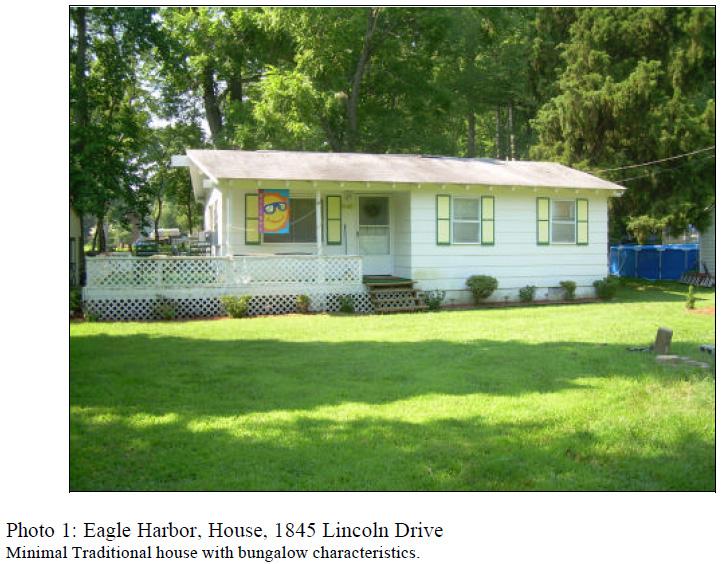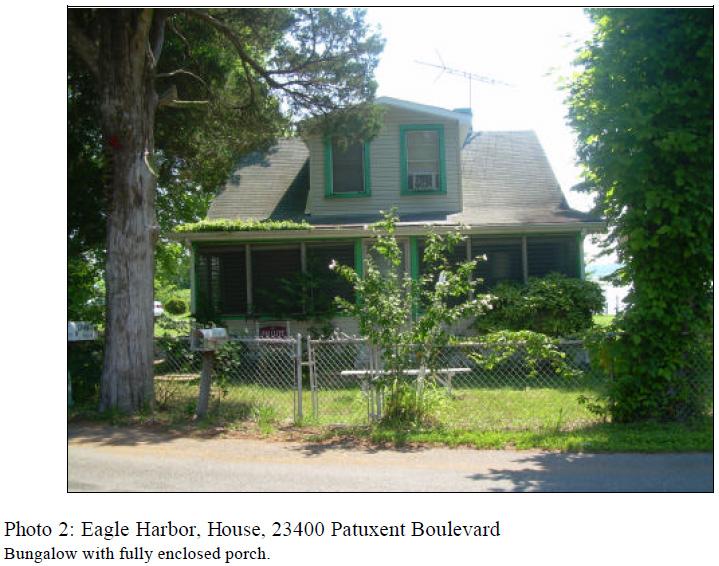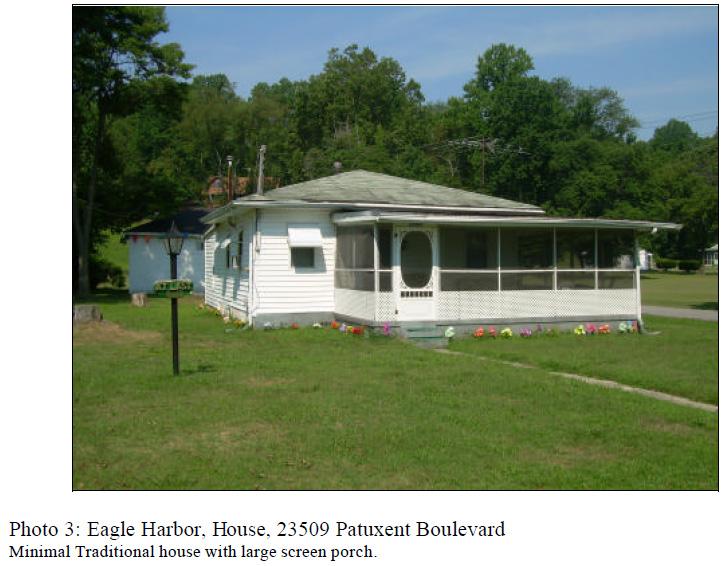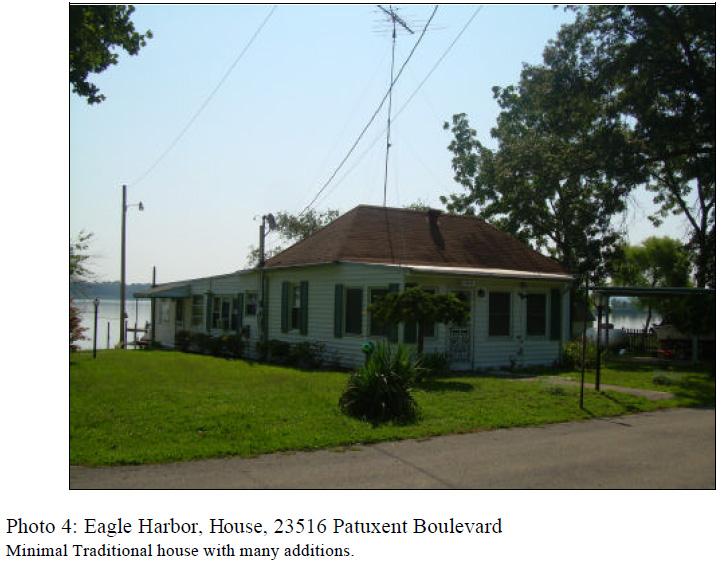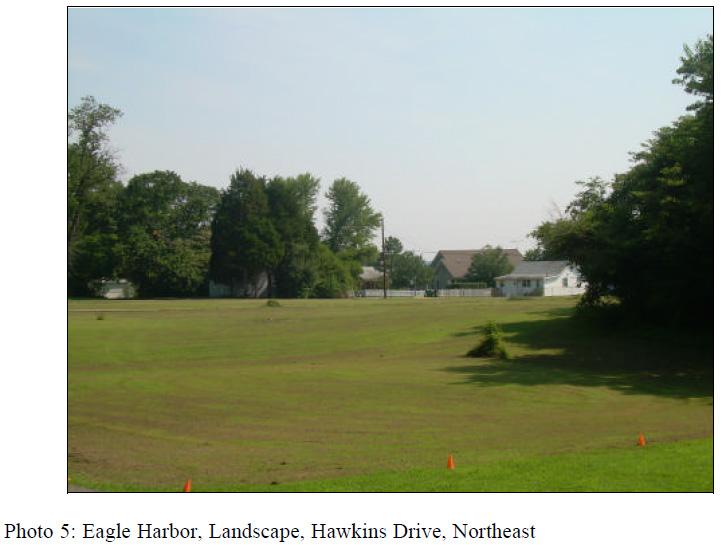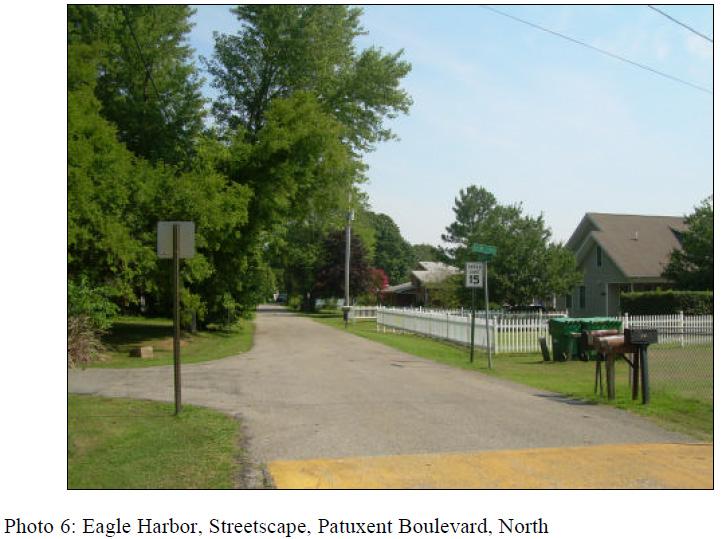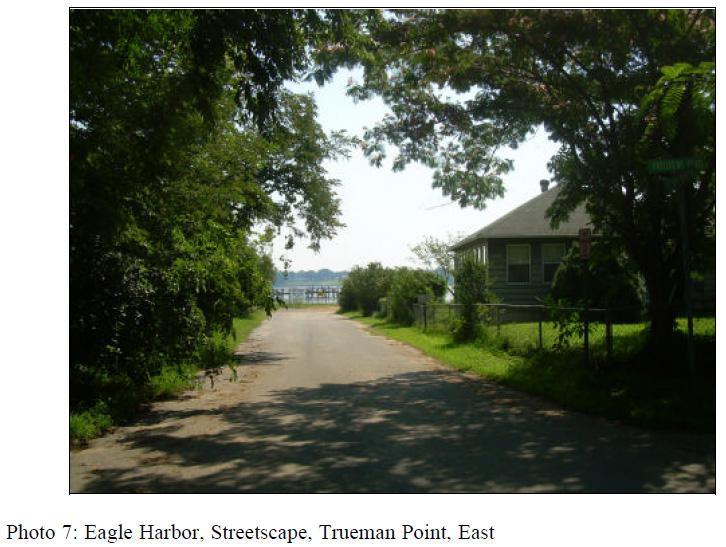List of African American Incorporated Towns in Prince George's County
Eagle Harbor
“The resort community of Eagle Harbor began to develop in the 1920s at the site of an ancient river port, Trueman Point (87B-028), on the Patuxent River.”1 Eagle Harbor is located 25 miles south of the beltway down Route 5, then through Brandywine and Aquasco along two-lane country roads. The town has no commercial establishments; the closest convenience store is three miles away. There are no police or fire departments and the residents say they rarely have any problems other than the occasional burglary of a vacant summer property.
Trueman Point on the Patuxent served as the river port for Aquasco farmers throughout the eighteenth and nineteenth centuries. In 1747, it was considered for designation as an official tobacco inspection warehouse, and although this designation was never realized, Trueman Point did connect the farmers of southern Prince George’s County with Baltimore and other ports, and it continued to be heavily used by local planters for shipping tobacco and other merchandise.2
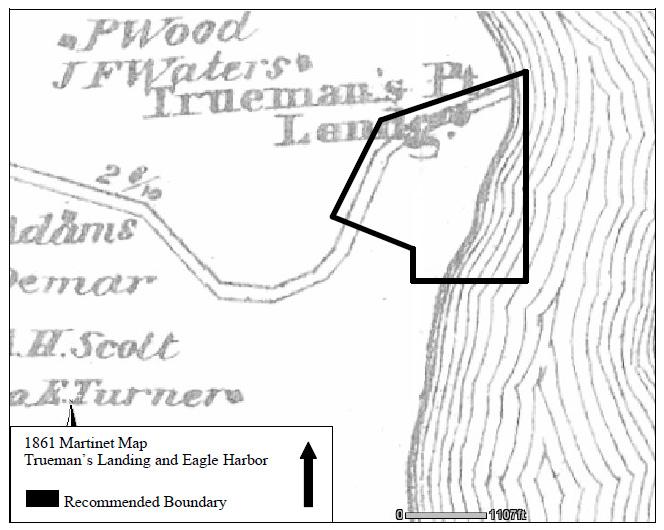
In the nineteenth century, Trueman’s Point was acquired by Weem’s Steamboat Company and served as a steamboat port into the wentieth century. In 1925, developer Walter L. Bean purchased several parcels of land from families who had lo ng owned considerable amounts of land in area. One such farm was owned by a white family, Thomas Wood and his family. The area was originally known as Woodville. Bean purchased this land, adjacent to Trueman Point, with the idea of creating a resort community for African-Americans from the Washington area.
Bean’s land was surveyed and platted in small lots which were then heavily advertised in the African-American newspapers of Washington, DC. The sales manager for Eagle Harbor was M. Jones, who during the years of 1925 and 1926 released voluminous advertisements for the new resort. Advertisements in the Washington Tribune in the mid 1920s boast “500 Plots at 1 Cent, Payable 20% down and balance in 40 equal Weekly Payments”, the new $50,000 Hotel will “Double Values at Eagle Harbor within the next thirty days!” and “Come to Eagle Harbor Plenty of accommodations for Vactionists and Week-End Parties Fine Beach, Bathing, Boating, Fishing, Merry-go-round, Cafes, Tea Rooms, Boarding Houses, Sugar Bowl Bath House, Large Excursion Boat. And Ideal Place for Sunday School and Private Picnics. Fishing Parties and Week-end Visitors!”3
The resort was only 30 miles from Washington over fine roads, and the community would be “a high class summer colony for the better people.”4 Lots were offered for $50 or less, and prospective buyers could (for $1.00 round-trip bus fare) visit the resort for inspection. The sales office was located in the Shaw section of Washington, the busy location of theaters, offices and businesses of successful black businessmen and professionals.5 This was a period when Highland beach, north of Annapolis, was a popular resort community, and Eagle Harbor also began to attract a good number of middle class African-American residents of Washington. People began building small cottages for their summertime use, and by 1928, the Eagle Harbor Citizens Association was already exploring the idea of incorporation, the town was officially incorporated in 1929.6
The Washington Tribune ran short articles in the 1920s focusing on the Eagle Harbor news. Social topics such as who visited who and what was the weekend entertainment were mentioned. Public notices were also posted during local Eagle Harbor elections.
Specifically, the public notice for the voting that will make “Eagle Harbor the smallest incorporated municipality in the county” mentions the purpose of “determining whether the citizens of said Eagle Harbor desire to form an incorporated town” and the location and times of the polling places.7
Just over a year after Walter Bean began the process of developing Eagle Harbor, the Maryland Development Corporation began urchasing property immediately to the north, also fronting on the Patuxent, with the goal of developing another resort community.8
This second community, Cedar Haven, never equaled Eagle Harbor’s success as a resort, and much of its land has remained undeveloped.
Eagle Harbor is still a small and quiet river front community; there are piers for fishing and boating, a town hall and public parkland, but not a trace today of the several hotels which once attracted visitors. In recent years, Trueman’s Point has become a popular spot for church baptisms, “with busloads of worshippers arriving each summer for ‘total immersion’ ceremonies in the shallows of the Patuxent.”9 Although the baptisms continue, swimming is no longer allowed due to the quicksand- like pull of the silt on the bottom of the river.
Today in Eagle Harbor there are approximately 60 dwellings, only four of which are from the early building period; most of the buildings are for summer use only, and for most of the year the atmosphere of the community is quiet and rural. 10 In 1987 an article in the Washington Post described Eagle Harbor as “a concentration of older clapboard and cinder block houses, mostly painted yellow, green and white. There are picnic tables, metal lawn chair sets and fishing boats in almost every yard.”11 The area is true to its rustic resort roots with homes having wells for drinking water and private septic tanks.
Some houses are purported to still have their outhouses although their current use is unknown. There is very little turnover in houses with many being passed down within the same family. There was growing concern in the 1980s about the influx of white residents and the possibility of a larger development ‘takeover’. In the 2001 Washington Post Article “Safe Harbor on the Patuxent” Myrna White, chairman of the Town Commission whose grandfather was one of the founders of Eagle Harbor, stated regarding the increase in white population that “it’s something new for us, but no problem.”12
There are no historic resources in Eagle Harbor. Historic resource 87B-028 Trueman’s Point (Landing) is located to the northeast of the community, at the end of Trueman Point Road.
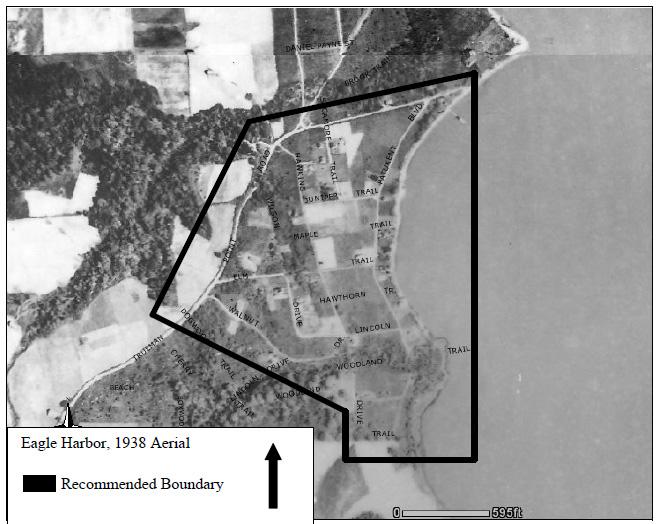
Works Cited
Pearl, Susan. African-American Heritage Survey 1996. The Maryland-National Capital Park & Planning Commission: Prince George’s County 1996.
The Washington Post. Various Articles. 1980s through 2001.
The Washington Tribune. Various Newspaper Articles and Advertisements. 1920s.
Windshield Survey
A windshield survey of Eagle Harbor was conducted in July of 2008 which counted 60 houses within the historic resort community. Eagle Harbor remains a small, rural community with only a handful of houses fronting the narrow streets and the water’s edge. The streets are narrow, single lane with no curbs, sidewalks, off-street parking or lights. The houses, which are mostly one or one-and-one-half story, gabled cottages and bungalows, often have porches and large, unfenced yards. Many of the houses have been modified by the replacement of original materials. Most of the properties have a small shed, a garage or outbuilding. Many of the lots were sold; however, due to the small size of the average lot, many lots were required to build, and today are vacant or unimproved.
Unlike the neighboring community of Cedar Haven where many of the lots never sold and dense foliage has grown over them, in Eagle Harbor open lots are extensive, manicured, open fields.

Historic District Evaluation
Eagle Harbor is representative of several Prince George’s County Heritage Themes including Black History and Social History. Eagle Harbor meets the following qualifications for designation as a historic district in Prince George’s County.
(1)(A)(i) and (iv) Eagle Harbor is an important example that survives today of an African-American community that developed during segregation. The community was designed specifically as a retreat for African-Americans.
(2)(A)(iv) The community of Eagle Harbor represents an important place of recreation for middle class African-Americans in the early to mid twentieth century.
The history of Eagle Harbor, in conjunction with that of Cedar Haven is a significant representation of an African-American resort community, which was very popular in an era of segregation and social change.
Eagle Harbor meets qualifications for designation on the National Register of Historic Places as a historic district under Criterion A, as an example of an African-American community that developed a resort destination.
- Pearl, Susan. African-American Heritage Survey 1996. The Maryland-National Capital Park & Planning Commission: Prince George’s County 1996, 111
- Pearl, Susan, 111
- The Washington Tribune. Various Newspaper Articles and Advertisements. 1920s.
- Pearl, Susan, 111
- The Washington Post. Various Articles. 1980s through 2001.
- Pearl, Susan, 111
- The Washington Tribune.
- Pearl, Susan, 111
- The Washington Post.
- Pearl, Susan, 111
- The Washington Post.
- The Washington Post.
